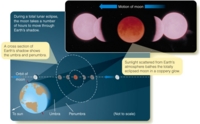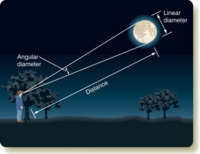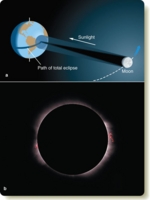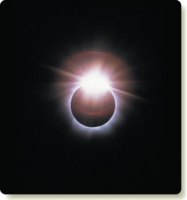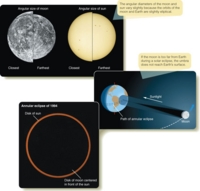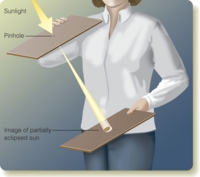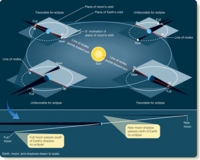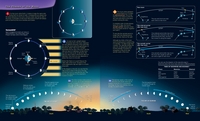|
|
YOU HAVE NO DOUBT SEEN THE MOON in the sky and noticed its changing shapes. The cycle of the moon is one of the most obvious phenomena in the sky.
The Motion of the MoonJust as the planets revolve counterclockwise around the sun, the moon revolves counterclockwise around Earth. Because the moon’s orbit is tipped a few degrees from the plane of Earth’s orbit, the moon wanders slightly north and south of the ecliptic, but it is always somewhere along the band of the zodiac. Next time you notice the moon, check on it a few hours later and you will be able to see it moving eastward along its orbit.
The moon moves rapidly against the background of the constellations. If you watch the moon for just an hour, you can see it move eastward by slightly more than its angular diameter. In the previous chapter, you discovered that the moon is about 0.5° in angular diameter, so it moves eastward a bit more than 0.5° per hour. In 24 hours, it moves 13°. Each night when you look at the moon, you see it about 13° eastward of its location the night before.
As it moves around Earth, the shape of the moon changes, and that cycle has been a natural timekeeper since the dawn of human civilization.
The Cycle of PhasesThe changing shape of the moon as it orbits Earth is one of the most easily observed phenomena in astronomy. How often have you noticed the full moon rising dramatically or a thin crescent moon hanging in the evening sky? Study The Phases of the Moon on pages 30–31 and notice three important points:
- First, the moon always keeps the same side facing Earth, and you never see the far side of the moon. “The man in the moon” is produced by the familiar features on the moon’s near side, and the far side is never visible from Earth.
- Second, the changing shape of the moon as it passes through its cycle of phases is produced by sunlight illuminating different parts of the side of the moon you can see.
- The third thing to notice is the difference between the orbital period of the moon around Earth and the length of the lunar phase cycle. That difference is a good illustration of how your view from Earth is produced by the combined motions of Earth and other heavenly bodies such as the sun and moon.
You can make a moon-phase dial from the middle diagram on page 30 by covering the lower half of the moon’s orbit with a sheet of paper, aligning the edge of the paper to pass through the word “Full” at the left and the word “New” at the right. Push a pin through the edge of the paper at Earth’s North Pole to make a pivot and, under the word “Full,” write on the paper “Eastern Horizon.” Under the word “New,” write “Western Horizon.” The paper now represents the horizon you see facing south.
You can set your moon-phase dial for a given time by rotating the diagram behind the horizon-paper. For example, set the dial to sunset by turning the diagram until the human figure labeled “sunset” is standing at the top of the Earth globe; the dial shows, for example, that the full moon at sunset would be at the eastern horizon.
The phases of the moon are dramatic, and they have attracted a number of peculiar ideas. You have probably heard a number of Common Misconceptions about the moon. Sometimes people are surprised to see the moon in the daytime sky, and they think something has gone wrong! No, the gibbous moon is often visible in the daytime, although quarter moons and especially crescent moons are harder to see when the sun is above the horizon. You may hear people mention “the dark side of the moon,” but you will be able to assure them that there is no dark side. Any location on the moon is sunlit for two weeks and is in darkness for two weeks as the moon rotates in sunlight. Also, you may have heard people say the moon is larger when it is on the horizon. Certainly the rising full moon looks big when you see it on the horizon, but that is an optical illusion. In reality, the moon is the same size on the horizon as when it is high overhead. Finally, you have probably heard one of the strangest misconceptions about the moon: that people tend to act up at full moon. Actual statistical studies of records from schools, prisons, hospitals, and so on show that it isn’t true. There are always a few people who misbehave; the moon has nothing to do with it.
For billions of years, the man in the moon has looked down on Earth. Ancient civilizations saw the same cycle of phases that you see (Figure 3-3), and even the dinosaurs may have noticed the changing phases of the moon. Occasionally, however, the moon displays more complicated moods when it turns copper-red in a lunar eclipse.
Lunar EclipsesAt full moon, the moon is opposite the sun in the sky, but, because the moon’s orbit is tipped a few degrees, it usually passes north or south of Earth’s shadow. If, however, it actually passes through the shadow, sunlight is cut off, and you see a lunar eclipse.
Earth’s shadow consists of two parts (Figure 3-4). The umbra is the region of total shadow. If you were drifting in your spacesuit in the umbra of Earth’s shadow, the sun would be completely hidden behind Earth, and you would see no portion of the sun’s bright disk. If you drifted into the penumbra, however, you would see part of the sun peeking around the edge of Earth, so you would be in partial shadow. In the penumbra, sunlight is dimmed but not extinguished.
Once or twice a year, the orbit of the moon carries it through the umbra of Earth’s shadow, and you see a total lunar eclipse (Figure 3-5). As you watch the moon in the sky, it first moves into the penumbra and dims slightly; the deeper it moves into the penumbra, the more it dims. In about an hour, the moon reaches the umbra, and you see the umbral shadow darken part of the moon. It takes about an hour for the moon to enter the umbra completely and become totally eclipsed. Totality, the period of total eclipse, may last as long as 1 hour 45 minutes, though the timing of the eclipse depends on where the moon crosses the shadow.
When the moon is totally eclipsed, it does not disappear completely. Although it receives no direct sunlight, the moon in the umbra does receive some sunlight refracted (bent) through Earth’s atmosphere. If you were on the moon during totality, you would not see any part of the sun because it would be entirely hidden behind Earth. However, you would be able to see Earth’s atmosphere illuminated from behind by the sun. The red glow from this ring of “sunsets” and “sunrises” illuminates the moon during totality and makes it glow coppery red, as shown in Figure 3-5.
If the moon passes a bit too far north or south, it may only partially enter the umbra, and you see a partial lunar eclipse. The part of the moon that remains outside the umbra in the penumbra receives some direct sunlight, and the glare is usually great enough to prevent your seeing the faint coppery glow of the part of the moon in the umbra.
A penumbral lunar eclipse occurs when the moon passes through the penumbra but misses the umbra entirely. Because the penumbra is a region of partial shadow, the moon is only partially dimmed. A penumbral eclipse is not very impressive.
Although there are usually no more than one or two lunar eclipses each year, it is not difficult to see one. You need only be on the dark side of Earth when the moon passes through Earth’s shadow. That is, the eclipse must occur between sunset and sunrise at your location. Table 3-1 will allow you to determine which upcoming total and partial lunar eclipses will be visible from your location.
Solar EclipsesFrom Earth you can see a phenomenon that is not visible from most planets. It happens that the sun is 400 times larger than our moon and, on the average, 390 times farther away, so the sun and moon have nearly equal angular diameters, about 0.5°. (See Reasoning with Numbers 3-1.) That means that the moon is just the right size to cover the bright disk of the sun and cause a solar eclipse. If the moon covers the entire disk of the sun, you see a total eclipse. If it covers only part of the sun, you see a partial eclipse.
Whether you see a total or partial eclipse depends on whether you are in the umbra or the penumbra of the moon’s shadow. The umbra of the moon’s shadow barely reaches Earth and casts a small circular shadow (Figure 3-7a). The shadow is never larger than 270 km (168 miles) in diameter. Standing in that umbral spot, you would be in total shadow, unable to see any part of the sun’s bright surface, and the eclipse would be total (Figure 3-7b). But if you were located outside the umbra, in the penumbra, you would see part of the sun peeking around the edge of the moon, and the eclipse would be partial. Of course, if you are outside the penumbra, you see no eclipse at all.
Because of the orbital motion of the moon and the rotation of Earth, the moon’s shadow sweeps rapidly across Earth in a long, narrow path of totality. If you want to see a total solar eclipse, you must be in the path of totality. When the umbra of the moon’s shadow sweeps over you, you see one of the most dramatic sights in the sky—the totally eclipsed sun.
The eclipse begins as the moon slowly crosses in front of the sun. It takes about an hour for the moon to cover the solar disk, but as the last sliver of sun disappears, dark falls in a few seconds. Automatic streetlights come on, drivers of cars turn on their headlights, and birds go to roost. The sky becomes so dark you can even see the brighter stars.
The darkness lasts only a few minutes because the umbra is never more than 270 km (168 miles) in diameter and sweeps across Earth’s surface at over 1600 km/hr (1000 mph). The sun cannot remain totally eclipsed for more than 7.5 minutes, and the average period of totality lasts only 2 or 3 minutes.
The brilliant surface of the sun is called the photosphere. When the moon covers the photosphere, you can see the fainter chromosphere, the higher layers of the sun’s atmosphere, glowing a bright pink. Above the chromosphere you see the corona, the sun’s outer atmosphere (Figure 3-8). The corona is a low-density, hot gas that glows with a pale white color. Streamers caused by the solar magnetic field streak the corona, as may be seen in the last frame of Figure 3-8. The chromosphere is often marked by eruptions on the solar surface called prominences (see Figure 3-7b). The corona, chromosphere, and prominences are visible only when the brilliant photosphere is covered. As soon as part of the photosphere reappears, the fainter corona, chromosphere, and prominences vanish in the glare, and totality is over. The moon moves on in its orbit, and in an hour the sun is completely visible again.
Just as totality begins or ends, a small part of the photosphere can peek out from behind the moon through a valley at the edge of the lunar disk. Although it is intensely bright, such a small part of the photosphere does not completely drown out the fainter corona, which forms a silvery ring of light with the brilliant spot of photosphere gleaming like a diamond (Figure 3-9). This diamond-ring effect is one of the most spectacular of astronomical sights, but it is not visible during every solar eclipse. Its occurrence depends on the exact orientation and motion of the moon.
Sometimes when the moon crosses in front of the sun, it is too small to produce a total eclipse. The moon follows a slightly elliptical orbit around Earth, and consequently its angular diameter can vary (Figure 3-10). When it is at perigee, its point of closest approach to Earth, it looks significantly larger than when it is at apogee, the most distant point in its orbit. Furthermore, Earth’s orbit is slightly elliptical, so the Earth–sun distance varies slightly, and that makes the angular diameter of the solar disk vary slightly. If the moon is in the farther part of its orbit during totality, its angular diameter will be less than the angular diameter of the sun, and if that happens, you see an annular eclipse, a solar eclipse in which a ring (or annulus) of the photosphere is visible around the disk of the moon. With a portion of the brilliant photosphere visible, it never quite gets dark, and you can’t see the prominences, chromosphere, and corona (Figure 3-10).
A list of future total and annular eclipses of the sun is given in Table 3-2. If you plan to observe a solar eclipse, remember that the sun is bright enough to burn your eyes and cause permanent damage if you look at it directly. It is a Common Misconception that sunlight during an eclipse is somehow dangerous. Sunlight is bright enough to burn your eyes any day whether there is an eclipse or not. Only during totality, while the brilliant photosphere is entirely hidden, is it safe to look directly at the eclipse. See Figure 3-11 for a safe way to observe the partially eclipsed sun.
Predicting EclipsesPredicting lunar or solar eclipses seems quite complex, and if you wanted to make precise predictions, you would have to do some sophisticated calculations. But you can make general eclipse predictions by thinking about the geometry of an eclipse and the cyclic motions of the sun and moon.
You see a solar eclipse when the moon passes between Earth and the sun, that is, when the lunar phase is new moon. You see a lunar eclipse at full moon. However, you don’t see solar eclipses at every new moon or lunar eclipses at every full moon. Why not? That’s the key question. The answer is that the moon’s orbit is tipped a few degrees so at most new or full moons, the shadows miss, and there are no eclipses.
For an eclipse to occur, the moon must reach full or new moon just as it passes through the plane of Earth’s orbit; otherwise, the shadows miss. The points where it passes through the plane of Earth’s orbit are called the nodes of the moon’s orbit, and the line connecting these is called the line of nodes. In other words, the planes of the two orbits intersect along the line of nodes. Twice a year, this line of nodes points toward the sun, and for a few weeks eclipses are possible at new moons and full moons (Figure 3-12). These intervals when eclipses are possible are called eclipse seasons, and they occur about 6 months apart.
If the moon’s orbit were fixed in space, the eclipse seasons would always occur at the same time each year. The moon’s orbit precesses, however, because of the gravitational pull of the sun on the moon, and the precession slowly changes the direction of the line of nodes. The line turns westward, making one complete rotation in 18.61 years. As a result, the eclipse seasons occur about 3 weeks earlier each year. Many ancient peoples noticed this pattern and could guess which full and new moons were likely to produce eclipses.
Another way the ancients predicted eclipses was to notice that the pattern of eclipses repeats every 6585.3 days—the Saros cycle. After one Saros, the sun, moon, and nodes have circled the sky many times and finally returned to the same arrangement they occupied when the Saros began. Then the cycle of eclipses begins to repeat. One Saros equals 18 years 11-1/3 days. Because of the extra third of a day, an eclipse visible in North America will recur after one Saros, but it will be visible one-third of the way around the world in the North Pacific. Once ancient astronomers recognized the Saros cycle, they could predict eclipses from records of previous eclipses.
What would astronauts on the moon observe while people on Earth were seeing a total lunar eclipse?
Building this argument requires that you change your point of view and imagine seeing an event from a new location. Remember that when you see a total lunar eclipse, Earth is passing between the moon and the sun, blocking the light that would normally light up the full moon. Astronauts standing on the moon would look up and see Earth crossing in front of the brilliant sun. The lunar day would begin to grow dim as the moon entered Earth’s penumbra. The visible part of the sun would grow narrower and narrower until it vanished entirely behind Earth, and the astronauts would be left standing in the dark as the moon carried them through the umbra of Earth’s shadow. Except for faint starlight, their only light would come from the faint glow of Earth’s atmosphere lit from behind, a red ring around the dark disk of Earth made up of every sunset and sunrise. The red light from Earth’s atmosphere would bathe the dusty plains and mountains of the moon in a copper-red glow. The astronauts would have a cold and tedious wait for the sun to reemerge from behind Earth, but they would see a lunar eclipse from a new and dramatic vantage point.
Imagining the same event from different points of view can help you sort out complex geometries. Now change your argument slightly and imagine the eclipse once again. If Earth had no atmosphere, how would this eclipse look different as viewed from Earth and from the moon?
Figure 3-3
In this sequence of the waxing moon, you see the same face of the moon, the same mountains, and craters, and plains, but the changing direction of sunlight produces the lunar phases. (© UC Regents/Lick Observatory)
Figure 3-4
The shadows cast by a map tack resemble those of Earth and the moon. The umbra is the region of total shadow; the penumbra is the region of partial shadow.
Figure 3-5
During a total lunar eclipse, the moon passes through Earth’s shadow, as shown in this multiple-exposure photograph. A longer exposure was used to record the moon while it was totally eclipsed. The moon’s path appears curved in the photo because of photographic effects. (© 1982 Dr. Jack B. Marling)
Active Figure 3-6
The three quantities related by the small-angle formula. Angular diameter is given in seconds of arc in the formula. Distance and linear diameter must be expressed in the same units—both in meters, both in light-years, and so on.
Figure 3-7
(a) The umbral shadow of the moon sweeps over a narrow strip of Earth. (b) From a location inside the umbral shadow, you would see the moon cover the bright surface of the sun in a total solar eclipse. (Daniel Good)
Figure 3-8
This sequence of photos shows the first half of a total solar eclipse. (Daniel Good)
Figure 3-9
The diamond-ring effect can sometimes occur momentarily at the beginning or end of totality if a small segment of the photosphere peeks out through a valley at the edge of the lunar disk. (NOAO)
Figure 3-10
An annular eclipse occurs when the moon is far enough from Earth that its umbral shadow does not reach Earth’s surface. From Earth, you see an annular eclipse because the moon’s angular diameter is smaller than the angular diameter of the sun. In the photograph, the dark disk of the moon is almost exactly centered on the bright disk of the sun. (top: © UC Regents/Lick Observatory; bottom: Daniel Good)
Figure 3-11
A safe way to view the partial phases of a solar eclipse. Use a pinhole in a card to project an image of the sun on a second card. The greater the distance between the cards, the larger (and fainter) the image will be.
Figure 3-12
The moon’s orbit is tipped about 5° to Earth’s orbit. The nodes N and N’ are the points where the moon passes through the plane of Earth’s orbit. If the line of nodes does not point at the sun, the long narrow shadows miss, and there are no eclipses at new moon and full moon. At those parts of Earth’s orbit where the line of nodes points toward the sun, eclipses are possible at new moon and full moon.
The Phases of the Moon
pages 30-31
Reasoning with Numbers 3-1
The Small-Angle Formula
Table 3-1
Total and Partial Eclipses of the Moon, 2007-2014
Table 3-2
Total and Annular Eclipses of the Sun, 2007-2017



